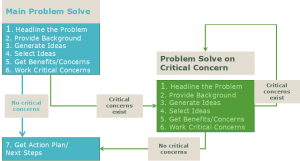Annex: Proposed Programme for a Roadmap Workshop
Day 1 – consent on Roadmap priorities
Orientation
We will start with a plenary orientation session to introduce the topic and have general introductions of the participants sharing their experience with this topic. After the break we will present the results of phase one. The orientation phase will end with a round table discussion on the main prioritization areas and continue in parallel sub-sessions to discuss discrepancies and challenges. A problem solving/team building methodology will be adopted following a simple seven step process:
- State the problem – the ‘headline’ – a concise, accurate, action-oriented statement regarding the draft roadmap formulated within the ‘how to’ (H2) format. This will invite the participants to problem solve and generate ideas rather than merely give opinions.
- Provide background to the problem – relevant facts and activities that led to the problem statement.
- Generate ideas for solutions – during the background statement, the team will have developed thoughts and suggestions on idea generation. Since we are trying to ‘open up’ the problem solving, offers of ideas are accepted without judgement. The facilitator will solicit ideas from each team member ensuring everybody has offered his/her ideas and thoughts before ‘opening the floor’.
- Select ideas to pursue – The selection step is part of the ‘closing down’ stage of the problem solving process and will be done by the selected the leader of the team. He/she will scan the ideas generated and select one or two to work further.
- Get benefits/concerns of selected ideas – list the benefits associated with the idea(s) selected. Concerns should be stated as ‘how to’ (H2) or ‘I wish I knew’ (IWIK) questions.
- If any critical concerns exist, work them using a mini problem solve – each concern is an opportunity to problem solve. Select the most critical concern and re-iterate the problem solving process, starting with additional background data and generating ideas to build on and overcome the concern. Concerns should be stated in a ‘how to’ format since they will invite the resources to problem solve.
- If no critical concerns remain, prepare action plan/next steps – To increase the chances of implementing problem solutions, the team members must have a thorough understanding of their roles and responsibilities concerning the action steps.
The process is represented graphically below:

Day 2 – action plan supported by stakeholders
The second day will be used to further generate and detail actions in three categories: policy actions, business development actions and R&D questions to work on. The group will be split to three sub groups according to own identification. The day will be structured in three sessions:
Idea generation: The idea generation will start with a few minutes of individual reflection of the orientation and idea generation, after which the participants will join their groups in front of their ‘own’ worksheets to continue. The groups will do two rounds of idea generation around the worksheets, changing from one sheet to another, reading others ideas and adding their own until each group had visited each three worksheet twice.
Analysis: The sub groups will be tasked to collaboratively group or cluster the initial ideas on their ‘own’ worksheet, without direct influence from the facilitators. The groups will be given rules to discuss and clarify unclear ideas, group similar ideas thematically into clusters, and develop headlines for the clusters on new notes. Additionally, they will be asked to prioritize actions and to illustrate a critical path between the actions towards achieving the goals selected at the start.
Consent: The drafting of the timeline will be a plenary session again. For each group a spokesperson will position the actions (idea clusters) on the roadmap canvas. The spokesperson of each group placed the actions to the timeline, while giving a three-minute presentation on the logic of the critical path and key assumptions. The workshop will finish with a wrap up presentation picking up the key goals and important themes on the discussion and finishing off with the next phases and when the stakeholders can expect further communication.
